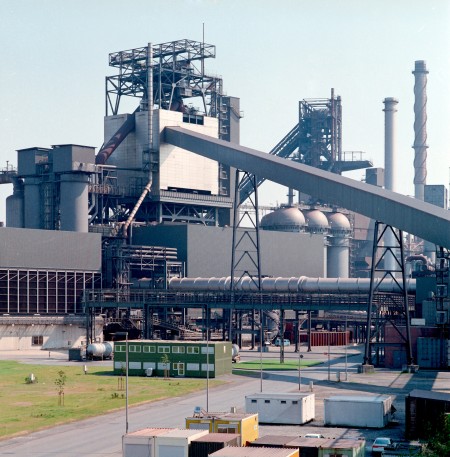Daily press, 2014-05-16, 11:38 am
First campaign ends after 21 years: Europe’s biggest blast furnace to be modernized

After 21 years, Europe’s biggest blast furnace, blast furnace 2 in Duisburg-Schwelgern, has ended its first campaign. In the middle of June the unit will be cooled down to allow modernization work to begin. First fired up on October 28, 1993, it will go back into operation at the end of September, so beginning its second campaign – the name given to the period between major overhauls. By last year the 14.9 meter hearth diameter furnace had already produced 75 million tons of iron, enough to build roughly 3,200 copies of the 400 meter Hohenzollern Bridge in Cologne – not including its thousands of “love locks”. The reline of blast furnace 2 represents a significant capital investment. Including dismantling and other maintenance and repair work ThyssenKrupp Steel Europe is spending more than 200 million euros on the project. In preparation for the reline, blast furnace 9 in Duisburg-Hamborn was restarted in October 2013 to produce the required amount of hot metal for the production process.
12,000 tons of iron a day
In the blast furnace, iron ores are reduced to metallic iron with the aid of coke and pulverized coal. The solid mass is melted by the injection of hot air, generating temperatures in excess of 2,000 degrees. The liquid iron flows to the bottom of the blast furnace and is drained through tap holes. It is then transported in refractory vessels to one of two basic oxygen steelmaking shops where it is converted into high-quality steel, which in turn is processed into slabs and finally sheet metal for use in cars and domestic appliances. Schwelgern 2 blast furnace is 90 meters tall and produces around 12,000 tons of iron a day. For this, almost 19,000 tons of iron ore and up to 4,000 tons of coke have to be charged into the top of the furnace. Each day the unit gets through roughly 25 twenty-car freight trains of ore, sinter, coal and coke. 75,000 cubic meters of concrete, 43,700 tons of steel, 800 kilometers of electric cable and 35 kilometers of cooling pipes went into its original construction.
7,100 tons of refractory material for the furnace vessel
The blast furnace is being comprehensively modernized. For example its roughly two meter thick refractory lining is being fully replaced. Around 7,100 tons of refractory material will be needed for the 75 meter tall furnace vessel alone. A specialized contractor will carry out the relining work simultaneously from six platforms arranged at different levels. In addition the furnace cooling system is being modernized with the replacement of more than 2,300 copper cooling plates. Further repair and replacement work will take place in the cast house and in the hot blast stoves, gas cleaning system, slag granulator and expansion turbine, among other areas.
More than 1,000 workers will be involved
An approximately 300-strong team from ThyssenKrupp Steel Europe is handling this gigantic modernization project with the help of around 100 national and international contractors – a significant proportion of the work is being carried out by companies from other segments of the ThyssenKrupp Group. The reline will require the use of around 1,100 external personnel each day. It will be coordinated from a specially built 10,000 square meter container village. The mobile offices are the nerve center of the planning effort, but there is also enough space for fabrication and storage.
The current campaign life of blast furnace 2 of more than 20 years is unusually long for such a unit. Against this background modernization was essential, though it will not affect the capacity of the furnace. The project has been planned down to the last detail over a one and a half year period in order to keep downtime as short as possible. The project team drew on experience from previous relines to optimize work processes and carry out certain jobs – for example on the auxiliary units – before the furnace is shut down. Today, Schwelgern 2 blast furnace provides 550 jobs for employees of ThyssenKrupp Steel Europe, plus several times that number at service partners in the region.
Investment secures the future of Duisburg site
“With the reline of blast furnace 2 we are bringing another core unit in our production chain up to date,” says ThyssenKrupp Steel Europe board member Dr. Herbert Eichelkraut. “It’s an investment in the future and a good sign for the Duisburg site and our employees.”
ThyssenKrupp Steel Europe has four blast furnaces in total. The two units in Duisburg-Hamborn, the conspicuous red-colored blast furnace 8 and the recently relined blast furnace 9, together produce around 3.7 million tons of hot metal per year. The two blast furnaces 1 and 2 in Duisburg-Schwelgern are roughly twice as big and have a combined output of roughly 7.7 million tons per year. How the four blast furnaces are operated in the future will depend on further market developments.




